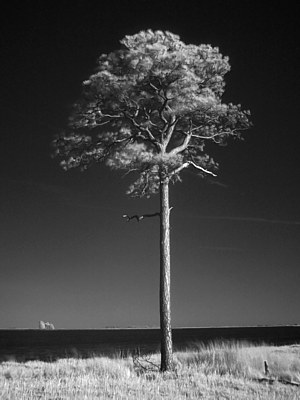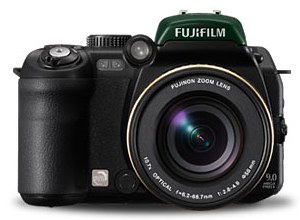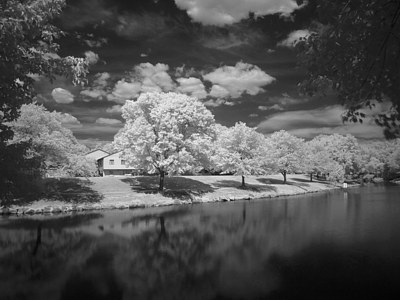From the beginning of my digital experience, I've been enjoying the possibility of taking pictures in infrared. Dark skies, surreal tonality, bright foliage — no amount of postprocessing will create the same result. The process is also simpler, easier, and more predictable than shooting IR on film.
Still, it is not as easy and as reliable as it could have been — if camera makers cared. Here is why.
Maryland Eastern Shore; Olympus E-500, 14-34 mm F/3.5-5.6 ZD at 22 mm, R72 filter, 1.6 s at F/4.1, ISO 100 (+4 EV exposure compensation)

Working against the system?
Digital image sensors are quite sensitive to near-infrared, i.e., wavelengths just above the 700-nanometer human eye response limit. Even the microscopic RGB filters placed over every photosite to make it record only the red, green, or blue component of the image do not drastically affect that sensitivity (at least not in the red component). This means that, as long as we use an IR filter to cut off the visible light, taking infrared images should be a snap. Well, it should, but it is not.
It turns out that this infrared response may hurt the color rendition. Because 99.9% of digital camera users will never try infrared photography, the manufacturers solved the problem in the most economical way: by placing an IR-absorbing filter just in front of the sensor (usually it is combined with the anti-aliasing filter; see my article in Quest 16 on the Leica M8).
The bottom line is that this anti-IR filter blocks about 99% of the infrared light from reaching the sensor. The remaining 1% (which is still here just because it is not easy to make a filter changing the transmittivity from 100% to 0% within just a few tens of nanometers) is all what's remaining for us infrared enthusiasts to work with. No wonder that a typical exposure with the most common R72 IR filter is about 1000x longer than in visible light (E-510). This usually means shutter speeds of one second or longer, which excludes moving subjects and makes a tripod necessary.
Still, even working around the system and against the designers' intent, the results can be quite pleasing and I have a hundred or so frames to prove it.
Modifying your camera for infrared use
Fuji and Canon attempted to give us some choice here by offering versions of their models with the anti-IR filter being replaced with a flat piece of glass (to keep the optical path the same). These cameras, obviously, were never addressed at a wider audience, and, being priced significantly higher than their visible-light siblings, did not sell well; I believe they are not made any longer.

